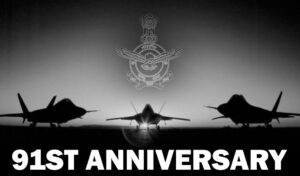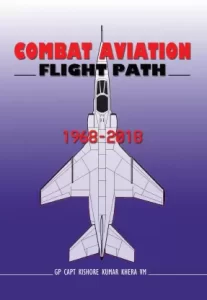This article has been contributed by a colleague of mine Gp Capt Kishore Kumar Khera. I found him to be totally ops oriented, focused and candid in his approach.

Pic Courtesy: Internet
In this article, Gp Capt Khera holistically reviews the challenges and capabilities of the IAF.
Coming Sunday, the Indian Air Force will be 91 and a perfect time for reflection. With two nuclear-powered neighbours, our current geostrategic environment is precarious as one of them is politically and economically fragile and the other is trying to flex its muscles on our borders. The standoff on northern borders has continued for the last three years with no signs of change. China has modernized its armed forces in the last three decades and reorganized them for better integration in 2016. Qualitatively and quantitatively, India can’t match Chinese military hardware. The only way forward for India is to use its resources in a focused manner to achieve its well-defined strategic goals. Lessons from the ongoing Russia-Ukraine war are very relevant in our context.
The challenges the Indian Air Force faces today relate not only to the situation on borders but also in terms of equipment and organisation.
The number of combat aircraft, the cutting-edge tools in a battle, is receding fast. Against an authorization of over 1000 combat aircraft, the Indian armed forces now are in the region of 600. This number will keep reducing and by 2030 is expected to go down to 450 with the phase-out of MiG-21, MiG-29, Jaguars and Mirage-2000. The induction of 36 Rafale and the very slow induction of LCA are only slowing down the force drawdown and cannot reverse it. The IAF needs to prepare for the next war with this realistic combat fleet strength. On the other hand, the induction of 56 new C295 transport aircraft replacing vintage Avro will boost the single wave airlift capability and offset the phase-out of Il-76 and An-32 fleets. In the helicopters, the capability will gradually increase with indigenous ALH and LCH. Unmanned systems are also gradually increasing and will share the workload of manned aircraft, especially in intelligence, surveillance, reconnaissance, ground and maritime attack roles. New and more capable radars, surface-to-air weapon systems and integrated networks are replacing the old systems giving a robust defensive capability. Will these be enough?
Recent and ongoing wars indicate the expansion of battlespace, the significance of battlespace transparency, time compression for action and offence-defence balance tilting in favour of offence. Military operation plans are based on two significant verticals- capability differential and information differential between the competing sides. A classical information matrix about the opposing force includes intent, strategy, military doctrine, and military objectives, Besides the overall direction that military strategy gives, an operational plan and its execution are based on an information matrix to achieve defined objectives with the least cost or in the minimum possible timeframe. IAF with its new doctrine IAP2000-22 endeavours to capture the essence of these changes and plans to transform itself into a smart force rather than a strong force. However, the equipment profile does not yet support the creation of a smart force. The number of AWACS, in-flight refuelers, and long-range weapons are rather limited. And in the surveillance and space domains, the resources are meagre. This poses a great challenge for the men and women in blues.
Organizationally, the integration of three wings of the Indian armed forces is likely to pick up pace in the coming years. With dwindling combat aircraft strength and meagre force multipliers, resource allocation and utilization for various theatres will define how successful the integration model is. Will there be a holistic approach for the utilization of resources or will India fritter away its limited combat resources to appease various theater commanders?
Public sector monopoly in defence has not yielded the desired results for the last seven decades. India has the dubious distinction of being the largest importer of military hardware in the last five decades. Atamnirbhar from being a rhetoric is gradually taking shape with orders being placed on Indian enterprises and a policy of earmarking part of the capital budget for Indian entities. Productivity and quality control of the public sector enterprises are yet to reach the requisite standards. The extremely low rate of production of LCA till now is a case in point. Along with this, the absence of technology and capabilities like aero engines, air-launched weapons, and electronic warfare systems remains critical. Opening up the defence sector for private entities, allowing DRDO to share available testing facilities and technology, and creating defence manufacturing corridors are steps in the right direction but not adequate at this juncture. MOUs with various foreign vendors have been signed but will these lead to requisite technology transfer, only time will tell. The impetus to R&D in these segments is imperative.
Indian Air Force needs to be ready with its limited assets and deter war. If it fails to deter then IAF will have to augment its limited resources with courage, ingenuity and smart resource employment to outwit the adversary. There are no runners up in war.
About The Author
Gp Capt Kishore Kumar Khera (Retd) VM
Group Captain Kishore Kumar Khera, served as a fighter pilot in the Indian Air Force for 33 years. He is an alumnus of the National Defence Academy and Defence Services Staff College. He has served in Plans and Operational Branches at Air Headquarters as well as in the High Commission of India, Dhaka, Bangladesh. He is a pioneer member of the Composite Battle Response and Analysis (COBRA) Group and headed the Operational Planning and Assessment Group at Air Headquarters. He conceptualised, designed and deployed multiple tools and processes for efficient and effective operational planning and execution. He was a Research Fellow at the Military Affairs Centre in the Institute for Defence Studies and Analyses, New Delhi. He is the author of the must-read book “Combat Aviation Flight Path”.

Suggestions and value additions are most welcome
For regular updates, please register here
References and credits
To all the online sites and channels.
Disclaimer:
Information and data included in the blog are for educational & non-commercial purposes only and have been carefully adapted, excerpted, or edited from sources deemed reliable and accurate. All copyrighted material belongs to respective owners and is provided only for purposes of wider dissemination.

